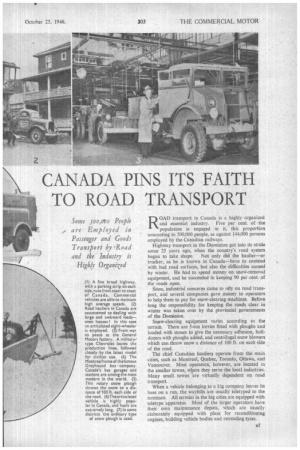CANADA PINS ITS FAITH TO ROAD TRANSPORT
Page 39

Page 40

If you've noticed an error in this article please click here to report it so we can fix it.
ROAD transport in Canada is a highly organized
and essential industry. Five per cent, of the population is engaged in it, this proportion amounting to 500,000 people, as against 144,000 persons employed by the Canadian railways.
Highway transport in the Dominion got into its stride some 25 years ago, when the country's road system
began to take shape. Not only did the haulier—or trucker, as he is known in Canada—have to contend with bad road surfaces, but also the difficulties caused by winter. He had to spend money on snow-removal equipment, and he succeeded in keeping 90 per cent. of the roads open.
Soon, industrial concerns came to rely on road transport, and several companies gave money to operators to help them to pay for snow-clearing machines. Before long the responsibility for keeping the roads clear in winter was taken over by the provincial governments of the Dominion.
Snow-clearing equipment varies according to the terrain. There are 5-ton lorries fitted with ploughs and loaded with stones to give the necessary adhesion, bulldozers with ploughs added, and centrifugal snow blowers which can. throw snow a distance of 100 ft. on each side of the road.
The chief Canadian hauliers operate from the main cities, such as Montreal, Quebec, Toronto, Ottawa, and Vancouver. Most operators, however, are located in the smaller towns, where they serve the local industries. Many small towns are virtually dependent on road transport.
When a vehicle belonging to a big company leaves its base on a run, the waybills are usually teletyped to the terminus. All termini in the big cities are equipped with teletype 'apparatus. Most of the larger operators have their own maintenance depots, which are usually elaborately equipped with plant for reconditioning engines, building vehicle bodies and retreading tyres.
The most popular type of vehicle used in Canada is articulated Oil engines are numerous._ Heavy and difficult loads are not uncommon, ranging from twostorey prefabricated houses to tracked steam shovels. On the highways terries generally cruise at about 35 m.p.h.
The chief federation of Canadian hauliers is the Canadian Automotive Transport Association. Each province has its own branch of the C.A.T.A„ .which exerts pressure on the local governments to maintain patrols to stop jhe unauthorized use of lorries, to investigate the position of hauliers seeking permits, and to keep the roads in good condition.
Canadian passenger transport operators carry 75,000,000 people annually over inter-urban routes. Coach and bus transport is popular in Canada, and operators cater as much as possible for public requirements. Some of the coach terminal buildings are the most modern in design in the world. Every large bus garage in Canada has excellent accommodation for drivers, the rooms being comparable with those of hotels.
Under the usual system of maintenance, when each bus has covered 2,000 miles, an inspection tag is attached to it, and when the vehicle enters its garage it is serviced accordingly. The process is also applied when buses have covered 5,000, 10,000 and 15,000 miles, and are due for the appropriate servicing.
Most Canadian long-distance coaches have oil engines. One of the longest bus routes is from Montreal to San Francisco, via Vancouver, a distance of 3,000 miles One may cross the Canadian-U.S. border freely, and there are 1,000 departures daily from Montreal for New York, Boston, Detroit and Chicago. More than 808,000 passengers leave the Montreal, terminal each month.
The size of Canada's road-transport industry dwarfs the railway systems. The development of this vast land has been and will be greatly dependent on the motor vehicle.












































































